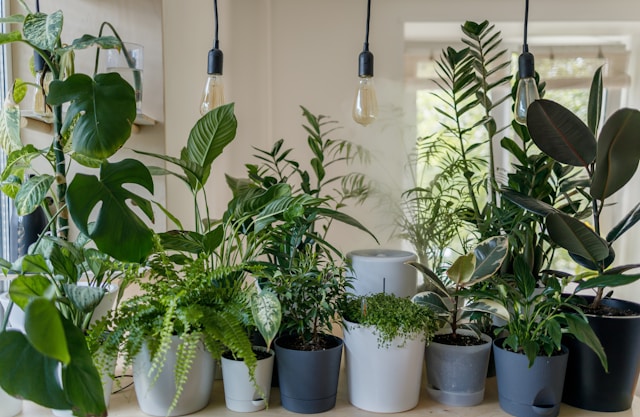The Ultimate Guide to Caring for Your Indoor Flowers

Bringing flowers in from outside makes your house feel more like the great outdoors with a splash of color, a good smell, and a lively vibe. But taking care of flowers indoors gets trickier than it looks. You can ensure your flowers are happy and make your home look better with the know-how. The extensive guide gives essential information on taking care of indoor plants, covering topics such as feeding, moving, controlling pests, and meeting their light and water needs. Let's jump right in to ensure your flowers stay green and bright all year long.
Choosing the Right Indoor Flowers
Before you begin keeping your flowers, make sure to select the right varieties for keeping indoors. Not all flowers thrive indoors, so picking those that can make it through indoors will be very important to you. Here are a few good choices:
- Peace Lily (Spathiphyllum): A good choice for beginning because it's relatively low maintenance and prefers not to be exposed to too much direct sunlight.
- African Violet (Saintpaulia): These pretty flowers like it when it's not too bright and they need to be kept moist.
- Orchid (Orchidaceae): This flower looks highly ornate and, with partial shades and highly humid climates, will sparkle beautifully.
- Geranium (Pelargonium): This type of geranium loves direct sun; therefore they flourish in bright sunlight where they will receive often watering.
- Begonia (Begonia x semperflorens-cultorum): This tough plant can handle a bit of shade and has bright flowers.
Understanding Light Requirements
Light is super important for your flowers' health. Some like it all out in the sun, while others are happy with a bit of shade. Here's what you need to know:
- Bright, Direct Light: Flowers like geraniums and begonias need a lot of sun, so put them near the south side of your house where they can get the most light.
- Bright, Indirect Light: Plants like peace lilies and orchids like a bit of filtered light. You can put them near a window with thin curtains or a bit away from the window to keep the light from being too harsh.
- Low Light: Some plants, like snake plants and ZZ plants, can handle not getting as light. If your room doesn't get much sun, think about getting flowers that like it that way.
Watering Your Indoor Flowers
While watering is essential, achieving the proper balance is essential. Too much water can make your flowers sick, and not enough can cause them to wilt. Here's what you need to know:
- Watering Frequency: Some flowers need to be watered every day, while others can go a few days without water. Usually, it's a good idea to water when the top inch of soil feels dry.
- Watering Method: Make sure you water your flowers slowly and deeply so the roots can soak up all the water. Plants can be carefully watered by using a watering can with a narrow spout, which keeps their leaves from being overly moist.
- Humidity Needs: If you have tropical indoor flowers, they love it when the air is a bit more humid. If your place is too dry, try spritzing your plants or putting them on a tray with water and pebbles to make the air moist.
Soil and Potting
For a plant to be healthy, the soil and pot are essential. Different plants like different soils, but most indoor flowers like soil that lets water drain well to avoid root rot.
- Well-Draining Soil: This helps stop root rot by letting water flow away.
- Soil Types: Some plants, like succulents and orchids, like soil that dries out fast, while African violets like soil that holds onto water.
- Repotting Frequency: It's a good idea to switch out your plant's pot every 1-2 years to give the soil a fresh start and let the roots grow.
- Pot Size: When you're moving your plant to a bigger pot, make sure it's not too big; you don't want water to pool around the roots.
Fertilizing Indoor Flowers
Plants require key nutrients to thrive, therefore it is vital to recognize that the soil may get reduced of these elements over time. Fertilization gives plants the nutrition they require to grow and flower.
- Types of Fertilizers: Use a balanced liquid fertilizer made for flowering plants, and look for ones with more phosphorus for more blooms. Organic options like compost tea or fish emulsion are also great for your indoor flowers.
- Fertilizing Frequency: Most indoor flowers need fertilization during their growing season, which is usually spring to fall. It is urged that you give your plants a dose every 4 to 6 weeks during this period. Take a break from feeding them in the winter when they're not growing as much.
- Signs of Over-Fertilization: If you see brown tips on your leaves or salt on the soil, it might mean you're giving your plants too much fertilizer. Always follow the instructions on the fertilizer and go easy on it, rather than giving too much.
Pruning and Deadheading
Trimming your indoor flowers is key to keeping them looking good, helping them grow, and stopping diseases. Deadheading, which is cutting off dead flowers, makes your plant want to make more flowers instead of wasting energy on the old ones.
- Pruning Tips: To assist with healing and disease prevention, trim off any dead or damaged leaves using sharp scissors or shears, and cut stems at a 45-degree angle.
- Deadheading: It is best to gently remove any faded or discolored blooms. This will make your plant want to make more flowers, look better, and stay balanced. Deadheading also helps prevent your plant from getting leggy or unbalanced.
Managing Pests and Diseases
Flowers inside can get attacked by bugs like aphids, spider mites, and fungus gnats. Spotting the first signs of these problems early and dealing with them quickly can stop your plants from getting hurt.
- Common Pests: Check for things like sticky stuff, webs, or tiny bugs on the leaves. Use natural fixes like neem oil, or soap for bugs, or bring in good bugs like ladybugs to eat the bad ones.
- Preventing Pests: Make sure to clean the leaves and look closely under them for any bugs. Keeping the area around your plant tidy, like cleaning off surfaces and pots, will help stop bugs from moving in.
- Diseases: Too much water can cause problems like fungal diseases like powdery mildew or root rot. Make sure your plants can drain properly, don't let water touch the leaves, and let air flow around them for best pest control.
Seasonal Care for Indoor Flowers
House plants might need different care depending on the time of year. Changing how you take care of them to match their natural growth will help them thrive.
- Spring and Summer: These are the times when most house plants are growing the most. Give them more water, feed them regularly, and make sure they get lots of light. Repot or trim them as needed to help them grow new leaves.
- Fall and Winter: As the days get shorter, your plants slow down in growth. Cut back on watering and fertilizing during these times. Put your plants in a sunny spot but not directly under the sun to make sure they get enough light.
Creating the Ideal Indoor Environment
The way you set up your home can affect how your flowers do. The main things to look out for are light, temperature, how humid it is, and how well the air moves.
- Temperature: 65–75°F (18–24°C) is great for most houseplants. Stay away from putting them near cold drafts, heat vents, or air conditioners because big temperature changes can hurt your plants.
- Humidity: Plants that like it hot need more humidity. You can make it more humid by spraying your plants or using a humidifier when it's dry.
- Air Circulation: Make sure the air around your plants is good so they don't get sick from fungus. Don't crowd them and if you need to, get a small fan.
Creating a Watering and Care Schedule
To keep up with all these care needs, think about making a plan for watering, feeding, pruning, and other important stuff. Here's a simple example:
- Weekly Tasks: Check how wet the soil is, water when it's dry, and get rid of any dead leaves or flowers.
- Monthly Tasks: Feed your plants (when they're growing) and look for bugs.
- Seasonal Tasks: Repot or trim your plants in the spring, and change how much water and light they get in the fall and winter.
Conclusion
Taking care of your indoor plants takes a bit of work, but with the right know-how and sticking to a routine, your plants will do great, bringing life and beauty to your home. By paying attention to what they need in terms of light, water, soil, and food, you can enjoy healthy, bright flowers all year long.











